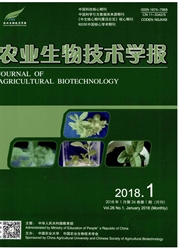

 中文摘要:
中文摘要:
通过模拟水稻土淹水过程,分析厌氧粘细菌(Anaeromyxobacter)群落结构随淹水时间的动态变化特征,揭示其群落结构变化与微生物Fe(Ⅲ)还原的内在联系。水稻土样品分别淹水处理1h、1d、5d、10d、20d和30d,采用PCR-RFLP方法分析厌氧粘细菌的群落结构的动态变化特征。测序序列提交NCBI,获得序列登录号为JF430083~JF4301440。应用厌氧泥浆培养方法,测定水稻土中Fe(Ⅲ)还原量变化。结果表明,在淹水不同时间处理中α多样性指数存在明显差异,淹水20d处理的多样性最高,而10d处理的最小。不同淹水时间处理共产生了11种优势类型(P1~P11),基于16SrRNA基因的系统发育分析将其分为3组。Group1和Group2分别包括5种优势类型均隶属于具有异化铁还原功能的厌氧粘细菌,其中P1优势类型在这两组中均存在。Group3与其他两组关系较远。不同淹水时期的水稻土中,厌氧粘细菌的群落结构发生着动态演替变化,其中Group1不仅与淹水前期的水铁矿还原有关,而且在淹水后期也与土壤中针铁矿还原能力密切相关。为进一步阐明厌氧粘细菌在土壤中的环境功能提供理论依据。
 英文摘要:
英文摘要:
In order to understand the internal relationship between the dynamic changes and characterization of microbial iron(Ⅲ) reduction in paddy soil, dynamic changes of community structure of Anaeromyxobacter were analyzed. Paddy soil samples were flooded 1 h, 1 d, 5 d, 10 d, 20 d, and 30 d respectively, and the dynamic changes of Anaeromyxobacter community structure were analyzed with PCR-RFLP technique. The 16S rRNA gene sequences obtained in this study have been submitted to NCBI under accession numbers JF430083~JF4301440. And reduction of Fe(Ⅲ) was determined with anaerobic slurry incubation method. The results showed that α diversity index among different flooding treatments illuminated distinct differences. The diversity was the highest in flooding 20 d treatment and the lowest in 10 d. In all samples, 11 RFLP-based dominant patterns(P1~P11) were found and divided into 3 groups based on 16S rRNA gene phylogenetic analysis. Group 1 and Group 2 included five dominant patterns respectively, one pattern(P1), was shared. And all the patterns in Group 1 and Group 2 were affiliated with Anaeromyxobacter capable of dissimilatory iron reduction. Group 3 was obviously different from the other two. In paddy soil treated with different flooding time, the dynamic succession of Anaeromyxobacter community structure occurred, and Anaeromyxobacter in Group 1 had close relationship with ferrihydrite reduction at flooding early phase and goethite reduction at the late stage. This research provides a theoretical basis to further clarify the environmental function of Anaeromyxobacter in soil."
 同期刊论文项目
同期刊论文项目
 同项目期刊论文
同项目期刊论文
 期刊信息
期刊信息
